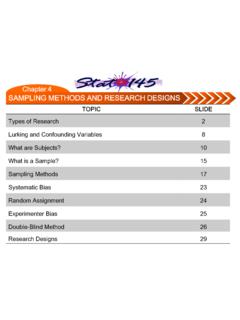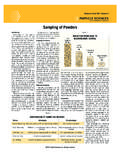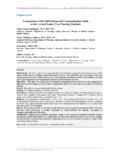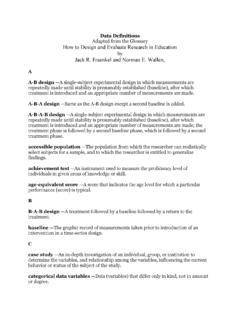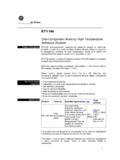Transcription of APPLIED MULTILEVEL ANALYSIS - Joop Hox home …
1 IAPPLIED HoxTT-Publikaties, Amsterdam1995iiCIP-GEGEVENS KONINKLIJKE BIBLIOTHEEK, DEN HAAGHox, MULTILEVEL ANALYSIS / Hox. - Amsterdam: Ill., fig., tab. + diskette- Index, 90-801073-2-8 NUGI 659 Trefw.: MULTILEVEL analyse 1995 HoxAll rights reserved. For noncommercial use only, this publication may be reproduced, stored in aretrieval system, or transmitted, in any form and by any means, electronic, mechanical,photocopying, recording, or otherwise, without the prior written permission of the author and thepublisher, provided the source is given and fully do we need special MULTILEVEL ANALYSIS techniques?.. described in this Regression basic two-level regression parameter estimates and ANALYSIS example of a simple two-level regression regression with HLM, VARCL and ANALYSIS of the example ANALYSIS of the example ANALYSIS of the example Applications of MULTILEVEL Regression models for data.
2 The ANALYSIS of Models for MULTILEVEL decomposition model for a hierarchical example of a MULTILEVEL factor example of a MULTILEVEL path implementation Aggregating and disaggregating in OF TABLEST able MULTILEVEL regression results interviewer/respondent Interviewer/respondent standardized Preliminary HLM ANALYSIS , outcome variable lonely HLM model with pupil variables only, results after 100 and betweenparentheses results after (10) HLM model with pupil variables HLM model with pupil and class Final HLM model with pupil and class Corrected final HLM model with pupil and class Summary of VARCL models for the example Estimates for the example data, model (5)..54 Table Final estimates for the example model with all pupil and teacher MLn model with all pupil and teacher , pupil and teacher variables, pupil gender results for 30 studies on job rates, intercept-only rates, fixed effect rates, fixed effect model, including rates, random coefficient rates for the three modes, based on Table , variances and ICC for family of family level benchmark of family level factor and family model, standardized factor level benchmark OF FIGURESF igure Interaction between interview condition and social assurance29 Figure for pupil gender in all Within families model for Van Peet Within + Between (independence) families model for Van Within + Between families model for Van Peet Pupil level path model for GALO path model for GALO data, with of making many books there is no end.
3 And much study is a weariness of the 12:12 This book is meant as a basic and fairly nontechnical introduction to multilevelanalysis, for APPLIED researchers in the social sciences. The term MULTILEVEL refersto a hierarchical or nested data structure, usually people within organizationalgroups, but the nesting may also consist of repeated measures within people, orrespondents within clusters as in cluster sampling. The expression Multilevelmodel or MULTILEVEL ANALYSIS is used as a generic term for all models for nesteddata. This book presents two MULTILEVEL models: the MULTILEVEL regression modeland a model for MULTILEVEL covariance thank Rian van Blokland-Vogelesang, Pieter van den Eeden, Edith deLeeuw, Godfried van den Wittenboer, and Tom Snijders for their comments onearlier drafts. I also thank Jaap Dronkers, Edith de Leeuw, Arie van Peet, BertSchijf and Kees van der Wolf for their permission to use their data for gratefully acknowledge the organizational support of my employingorganization, the Faculty of Educational Sciences of the University of , I have enjoyed the opportunity to stay as a Fulbright scholar at theDepartment of Psychology and the Social Statistics Program of the University ofCalifornia, Los Angeles.
4 I thank both organizations for providing a stimulatingresearch research has benefited from the lively discussions in various researchcommittees of which I am a member. I specifically want to mention theSOMO/NOSMO research committees on MULTILEVEL Research (MULOG) and onConceptualization and Research second edition of APPLIED MULTILEVEL ANALYSIS follows the text of the firstedition, with a few alterations. First, I have corrected a number of small errors inthe text and the equations. Second, I have incorporated a number of improvementssuggested in reviews by Ian Plewis and Rian van Blokland-Vogelesang. Third, Ihave rewritten part of the material on the programs HLM and MLn to reflectsoftware upgrades. Still, the chapter on HLM, VARCL and MLn should not beread as a complete introduction to the software; the available program packagesare much more powerful than I can show ANALYSIS is a complex and diverse field.
5 The goal of this book is toprovide an introduction to the basic approach and purpose. It can only give a firstimpression of the great diversity and depth of MULTILEVEL ANALYSIS . Several moreadvanced texts are available to researchers for further study. In addition, theMultilevel Models Project of The University of London publishes a MultilevelModelling Newsletter (information available via the MULTILEVEL modeling >. There is also an e-mail distribution list formultilevel research (via HoxAmsterdamSeptember 1995 Notes on the electronic edition:This is the complete text of the book APPLIED MULTILEVEL ANALYSIS . The book is nowout of print, and will not be reprinted because I feel it is becoming outdated. Sincemany people still consider it a very readable introduction to the basics ofmultilevel ANALYSIS , I have decided to make it available as an electronic webdocument.))
6 The usual copyright still applies; anyone may use this material fornoncommercial purposes, provided the original source is referenced and fully turn the original file into a PDF file, I have converted to a Windowsprogram. As a result, the page format has changed slightly, and the page numbersin the index may not be completely accurate. If readers send me corrections, I willinclude these in later electronic 199911. IntroductionSocial research often concerns problems that investigate the relationship betweenindividual and society. The general concept is that individuals interact with thesocial contexts to which they belong, meaning that individual persons areinfluenced by the social groups to which they belong, and that the properties ofthose groups are in turn influenced by the individuals who make up that the individuals and the social groups are conceptualized as ahierarchical system of individuals and groups, with individuals and groupsdefined at separate levels of this hierarchical system.
7 Naturally, such systems canbe observed at different hierarchical levels, and as a result may have variablesdefined at each level. This leads to research into the interaction between variablesthat describe the individuals and variables that describe the social groups, a kindof research that is now often referred to as ` MULTILEVEL research'.In MULTILEVEL research, the data structure in the population is hierarchical,and the sample data are viewed as a multistage sample from this hierarchicalpopulation. Thus, in educational research, the population consists of schools andpupils within these schools, and the sampling procedure proceeds in two stages:first we take a sample of schools, and next we take a sample of pupils within In this example, pupils are said to be nested within schools. Otherexamples are cross-national studies where the individuals are nested within theirnational units, organizational research with individuals nested withinorganizations, family research with family members within families, andmethodological research into interviewer effects with respondents nested withininterviewers.
8 Less obvious applications of MULTILEVEL models are longitudinalresearch and growth research where several distinct observations are nestedwithin individuals, and meta- ANALYSIS where the subjects are nested withindifferent studies. For simplicity I will mostly describe the MULTILEVEL models in this 1Of course in real research one may have a convenience sample at either level, or one maydecide not to sample pupils but to study all pupils in the sample of schools. Nevertheless, oneshould keep firmly in mind that the central notion is one of successive sampling from eachlevel of a hierarchical in terms of individuals nested within groups, and use examples about pupilsnested within schools, but note that the models apply to a much larger class ofanalysis MULTILEVEL research, variables can be defined at any level of the hierarchy. Someof these variables may be measured directly at their natural level; for example, atthe school level we may measure school size and denomination, and at the pupillevel intelligence and school success.
9 In addition, we may move variables from onelevel to another by aggregation or disaggregation. Aggregation means that thevariables at a lower level are moved to a higher level, for instance by computingthe school mean of the pupils' intelligence scores. Disaggregation means movingvariables to a lower level, for instance by assigning to all pupils a variable thatreflects the denomination of the school they belong to. Lazarsfeld and Menzel(1961) give a typology to describe the relations between different types ofvariables, defined at different levels. I present them in the following scheme,adapted from Swanborn (1981):Level: 123 et cetera_____Variableabsolute analyticaltype:relational structuralcontextual global analyticalrelational structuralcontextual global relational contextual In this scheme, the lowest level (level 1) is usually formed by the , this is not always the case.
10 Galtung (1969), for instance, defines roleswithin individuals as the lowest level, and in longitudinal designs one can definerepeated measures within individuals as the lowest level (Goldstein, 1986, 1989.)At each level, we have several types of variables. Global and absolute variables3refer only to the level at which they are defined, without reference to any otherunits or levels ('absolute variables' is simply the term used for global variablesdefined at the lowest level). A pupil's intelligence would be a global or absolutevariable. Relational variables also refer to one single level, they describe therelationships of a unit to the other units at the same level. Many sociometricindices (such as indices of popularity of indices of the reciprocality of relationships)are relational variables. Analytical and structural variables are measured byreferring to the subunits at a lower level.




